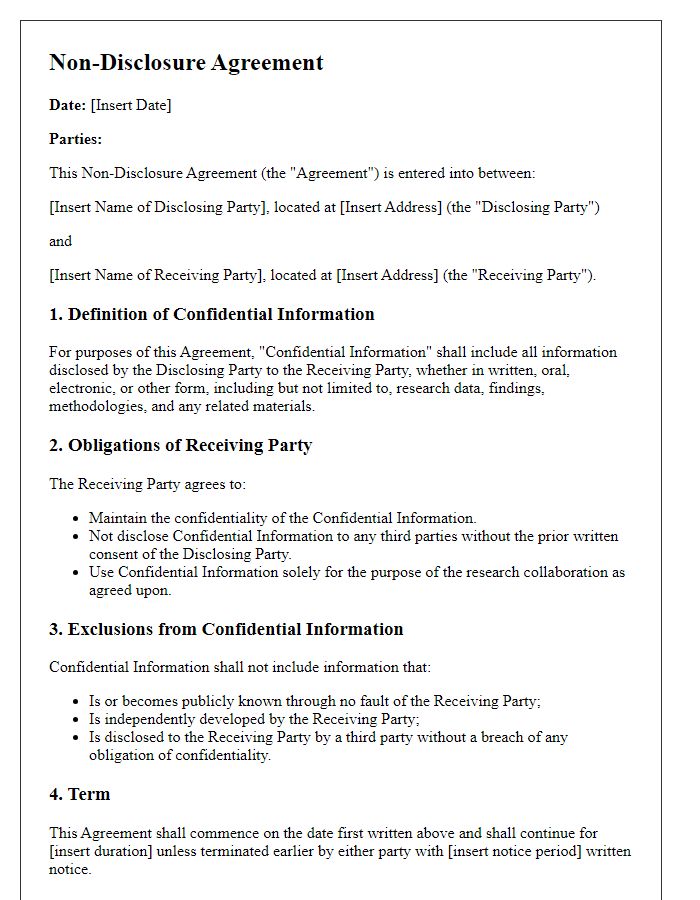Are you looking to protect your sensitive information while fostering collaborative relationships? A well-drafted non-disclosure agreement (NDA) can provide the assurance you need to share valuable insights without the fear of them being misused. In this article, we'll explore the essential elements for crafting an effective NDA proposal, ensuring that both parties feel secure and respected. Curious about how to get started with your own NDA? Read on for practical tips and templates!

Confidential Information Definition
A non-disclosure agreement (NDA) serves to protect sensitive information shared between parties, especially in business contexts. Confidential information encompasses proprietary data, trade secrets, financial details, intellectual property, and strategic plans, which may include numbers, such as revenue projections or market analysis figures. This information may originate from corporations like tech giants or startups in sectors ranging from pharmaceuticals to software development. Specific examples include user data from applications or algorithms designed to enhance user experience, particularly in environments like Silicon Valley where innovation thrives. The boundaries for what constitutes confidential information must be clearly defined to ensure that both parties understand their obligations, creating a secure framework for collaboration and exploration of joint ventures or partnerships.
Obligations of Parties
In a Non-Disclosure Agreement (NDA) proposal, the obligations of the parties involved are crucial for protecting confidential information. Each party, the disclosing party (the individual or organization sharing sensitive information) and the receiving party (the individual or organization agreeing to keep that information confidential), must fulfill specific duties. The disclosing party must provide clear, marked, and identifiable confidential information, ensuring that the boundaries of what constitutes confidential data are defined. The receiving party, on the other hand, must agree to restrict access to the confidential information exclusively to authorized personnel within their organization, maintaining a reasonable level of care to protect the information from unauthorized disclosure. Both parties must refrain from using the confidential information for any purpose outside the scope of the agreement, such as competitive advantage or personal gain. The term of confidentiality can vary, often designated for a period of two to five years, ensuring ongoing protection for the disclosed information even after the agreement ends. Moreover, any breaches of these obligations can result in legal consequences, including monetary damages or injunctions, emphasizing the importance of compliance by both parties.
Permissible Disclosures
Permissible disclosures under a non-disclosure agreement (NDA) refer to specific instances where confidential information can be legally shared without breaching the agreement. Typical examples of such disclosures include government mandates by regulatory bodies like the Securities and Exchange Commission (SEC) or legal requirements imposed by courts, where parties must comply with subpoenas or other legal documents. Additionally, disclosures may occur when information is shared with employees, consultants, or partners for legitimate business purposes, provided these individuals are also bound by confidentiality duties. During due diligence processes, potential investors or acquirers may access confidential data, contingent upon them signing their own NDA terms. It's crucial to outline these permissible disclosures clearly in the NDA to protect the interests of all parties involved while maintaining compliance with applicable laws.
Duration of Agreement
The duration of a non-disclosure agreement (NDA) defines the specified time period during which confidential information remains protected. Typically, the NDA period can span from one to five years, depending on the nature of the information shared and the industry involved. For instance, tech companies often prefer a five-year duration to safeguard proprietary algorithms and trade secrets (critical for competitive advantage) while startups may opt for a shorter one-year term as they negotiate potential partnerships. Upon expiration, the protections may continue depending on the sensitivity of the information and the terms outlined within the agreement itself. Key elements to consider include renewal options, conditions for termination, and provisions for safeguarding any confidential materials beyond the specified duration.
Consequences of Breach
A breach of a non-disclosure agreement (NDA), such as the one between two parties discussing proprietary information, can have serious implications. Financial damages may arise, estimated in the thousands or even millions of dollars depending on the severity and nature of the disclosed confidential information. Legal action may ensue, requiring court involvement in locations such as Los Angeles County, California, where the agreement might be enforceable. In addition to monetary penalties, the offending party may face punitive damages as compensation for negligence. Reputational harm can also impact future business relationships, particularly for firms within competitive industries such as technology or pharmaceuticals. The possibility of injunctions, prohibiting further disclosures, emphasizes the importance of adherence to NDA terms.
Letter Template For Non-Disclosure Agreement Proposal Samples
Letter template of Non-Disclosure Agreement for Intellectual Property Protection













Comments